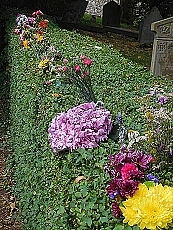Adam Yamey's Blog: YAMEY, page 120
July 12, 2022
The oyster merchant’s clock tower
BURNHAM-ON-CROUCH in Essex is a picturesque port on the River Crouch. Currently, it is a leisure resort and a centre for ship maintenance and boating. It was once famed for what grew in great numbers on the muddy bed under the water of the Crouch: oysters. For several centuries before the river became polluted in the 19th century, the oyster beds in the Crouch (and a few other places in Essex) were very profitable, providing much employment.
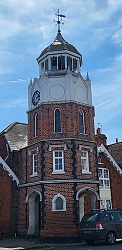
“On the shores of England the principal nurseries of oysters, not only for the English markets, but also for the foreign, are those on the coast of Essex and the estuaries adjoining: those taken there are called ‘ Natives/ Mr. Sweeting claims the name as peculiarly applicable to his fishery, as within his memory no strange oysters have ever been introduced…”
Men were required both to dredge the oyster beds and process the molluscs as well as to protect the precious creatures from thieves based in other places on the Essex coast.
Today (11th of July 2022), we visited the small but excellent museum in Burnham-on-Crouch. On the ground floor, we saw a retired mechanised oyster grading machine (made in France and capable of sorting 7000 oysters per hour) amongst the exhibits. On the upper floor of the museum, which is housed in a former boat repair building, we met the museum’s treasurer, who is a mine of interesting local history. He told us several things about Burnham’s oyster heydays. I hope that what I am about to tell you is a reasonably accurate summary of what he told us. If it is not totally accurate, I hope that he and you, dear reader, will forgive me.
For 10 years, I used to live in north Kent and often visited Whitstable to enjoy eating oysters for which this Kentish seaport is famous. The treasurer in Burnham told us that many of what are described as ‘Whitstable oysters’ were born in the mud beneath the river in Burnham-on-Crouch. From what I can recall, the young oysters, which grow in the mud beneath the Crouch, are dredged and then placed on boards to which they attach themselves. Keeping them submerged in seawater, the boards to which the young oysters are attached, were transported to Whitstable where they matured in its waters. The Burnham oysters were ‘native’, meaning that they began their lives there; they were not imported, as Thomas Campbell Eyton described in “A history of the oyster and the oyster fisheries” (published in 1858):
“On the shores of England the principal nurseries of oysters, not only for the English markets, but also for the foreign, are those on the coast of Essex and the estuaries adjoining: those taken there are called ‘Natives’. Mr. Sweeting claims the name as peculiarly applicable to his fishery, as within his memory no strange oysters have ever been introduced.”
One of the exhibits in the museum is a large model of the octagonal Victorian clock tower that dominates Burnham-on-Crouch’s High Street. The tower stands next to the building that used to house the former St Mary’s School. It was erected in 1877 to honour the local philanthropist Laban Sweeting (1793-1876). So, what, you might ask, and what has he got to with what I have been writing about?
Laban Sweeting, mentioned in the quoted from Eyton’s book, was a philanthropist; a member of The Burnham River Company; and he was one of the town’s oyster merchants. The museum has amongst its exhibits a small barrow, which used to be wheeled around Burnham by a member of the Sweeting family. It would have carried baskets of oysters ready for sale to the town’s populace.
We had visited Burnham once before, and although I was impressed by the clock tower, I knew nothing of its history. Neither did I know about the town’s association with oysters, which were poor people’s food in the 19th century, when chicken was a luxury. How times have changed.
July 11, 2022
Looking at Music
THE ESTORIC COLLECTION in London’s Highbury houses a fine permanent exhibition of modern Italian artworks, mainly creations of the so-called Futurists. In one of the galleries, I spotted the name of an artist who was born in a town, which I have visited, in the northeast of Italy: Gorizia. When the artist Anton Zoran Music (1909-2005) was born, Gorizia was part of the Austro-Hungarian empire. After WW1, the town became part of the Kingdom of Italy within the region of Venezia-Giulia. Soon after WW2, the eastern part of the region became absorbed into the Yugoslav republic of Slovenia (now an independent state). When that happened, the border between Italy and Slovenia ran through the eastern part og the town, the part in what was then Yugoslavia (a country I visited often between 1973 and 1990) became named ‘Nova Gorica’. Most of Gorizia, an attractive old town, is on the Italian side of the border.
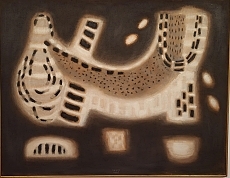
Slovenians still live on both sides of the border. Music, actually Anton Zoran Musič (pronounced mus-ich) was born into a Slovene-speaking family. Zoran, who went to schools in Maribor, studied art at the Academy of Fine Arts in Zagreb between 1930 and 1935. His first one-man exhibition (outside Yugoslavia) in Venice in 1943, where he had moved. Soon after this, he was arrested by the German Gestapo and then sent to Dachau concentration camp. After WW2, he moved to Ljubljana (in Yugoslavia), but soon shifted to Venice, where he lived (on and off) for the rest of his life. His career after the War was successful: he received several prestigious prizes for his artistic creations.
The Estorick displays five of Music’s paintings. They were created between 1951 and 1983 and illustrate his versatility as a painter. All the paintings hanging are between abstract and figurative in style, but slightly nearer the latter than the former. I had seen his paintings on previous visits to the Estorick, but until my most recent viewing of his art, I had not been aware of how many aspects of his life mesh with things that interest me.
July 10, 2022
A Soviet in Hampstead: Maxim Litvinov in north London
Here is an excerpt from my new book about Hampstead in north London:
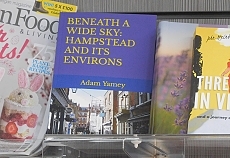
For many centuries, Hampstead has been the haunt of people involved in creative pursuits. So, it was no surprise that the former Express Dairy opposite Louis (patisserie) had at least one interesting cultural connection. In February 1916, the Bolshevik revolutionary Maxim Litvinov (1856-1951) proposed to his future wife Ivy Low in the café inside that branch of Express Dairy. Ivy, a novelist, was born, please note, in 1889 (she died in 1977). At the time he became acquainted with Ivy, Litvinov was with Lenin in London. Ivy did occasional typing for Maxim, and it was not long before they were attracted to one another. Passionate about cinema, he took her to watch films with him and one day he ‘popped the question’ in the Express Dairy. After they married, they lived in Hampstead until the outbreak of the Russian Revolution in October 1917. They did not return to Russia immediately because in January 1918 Maxim Litvinoff was made First Proletarian Envoy to the Court of St. James’s.
According to Zinovy Sheinis in his biography of Maxim first published in 1988, Maxim often went to Hampstead to meet his friends the Klyshkos, who lived on Hampstead High Street. Nikolai Klyshko (1880-1937) was a Bolshevik revolutionary of Polish parentage, who had settled in London and was a fluent Russian speaker. For a brief period, Litvinov lived in Hampstead with Klyshko and his English wife. Sheinis wrote about Maxim’s meeting with Ivy:
“They had met at a friend’s house. Then at a gathering of the Fabian Society. Litvinov was impressed by her knowledge of Tolstoy and Chekhov. Putting on weight, red-haired, of average height, well-mannered, and not very talkative, he made a big impression on the young writer. Her mother, the daughter of a colonel in the British Army, naturally wanted a different match for her daughter and certainly did not want to see her married to an insecure emigre from Russia. As for his religious background, Ivy Lowe simply never gave it a thought. She was herself from a family of Hungarian Jews who had taken part in the Kossuth uprising; in her girlhood she had been a Protestant, then had been converted to Catholicism. The choice of religion was her private affair and concerned no one else.”
After their marriage, they lived in a house, owned by Belgian refugees, in Hampstead’s South Hill Park (number 86). While there, Sheinis related:
“Friends sometimes gathered there in the evenings to discuss the political news; then an argument would flare up, developing into a fierce squabble. It always seemed to Ivy that her husband and his guests would any moment start flinging chairs at one another. At the very height of the dispute, when it was almost at boiling-point, she would leave the kitchen, go into the room, and announce that tea or coffee was ready. The disputants would calm down and drink their tea in peace.”
He also wrote that Ivy:
“… was not interested in and did not understand the political activities of her husband and his friends. To her, it was an alien world. In London, after the October Revolution, she asked her husband if he knew Lenin. Maxim replied that he had known Lenin for a long time. But she had no idea that letters from Lenin were coming to their house and that her flat was the headquarters of Bolshevik emigres.”
Later, they lived in a tiny house in West Hampstead. After that, Litvinov, having become a Soviet diplomat, moved from Hampstead. Despite not being officially accredited by the British, Sheinis noted:
“The Litvinovs were even invited to receptions. Though Soviet Russia was not yet recognised, its powerful influence reached standoffish London, Ivy Litvinova recollected.”
By 1921, the Litvinovs with their two young children, at least one of whom was born in Hampstead, settled in Moscow. Although Litvinov held high governmental posts in the Soviet Union and outside it (as a Soviet diplomat), he and Ivy, like so many other citizens in Stalin’s Russia, were constantly in fear of being arrested and/or killed.
My book about Hampstead, “BENEATH A WIDE SKY: HAMPSTEAD AND ITS ENVIRONS” is available from Amazon: https://www.amazon.co.uk/dp/B09R2WRK92
July 9, 2022
My childhood home in north London
I LIVED IN A detached house (see the picture) in north London’s Hampstead Garden Suburb during the first three decades of my life. My bedroom window was that on the first floor facing the street, Hampstead Way. Externally it looks much as it did when I lived there. This is not surprising because the houses in the Suburb are all subject to strict preservation orders,which forbid alterations of the appearances of the exteriors of the Suburb’s buildings.
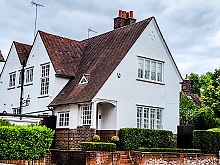
Although I was privileged to have lived in this part of London, it was never my favourite area of the city because during my youth, it was a dull place to be a child or even an adolescent.
By the way, although the name ‘Hampstead ‘ is part of the suburb’s name, the area is completely different from Hampstead proper: it lacks the vibrancy and vitality of old Hampstead village (or town, if you prefer). As a youngster, and still today, I have always enjoyed my visits to Hampstead Village
July 8, 2022
Benjamin Franklin and Saint Bartholomew
ONE OF LONDON’S FEW remaining pre-1666 (Fire of London) buildings is the church of St Bartholomew the Great close to Smithfield Market. Founded in the 12th century, the building has many Norman (Romanesque) features. It also contains some contemporary artefacts including “Colloquy” (a work made from glass) by Sophie Arkette, and “St Bartholomew. Exquisite Pain” (a work in gilded bronze) by Damien Hirst.
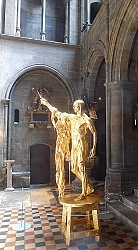 By Damien Hirst
By Damien HirstBeyond the chancel at the east end of the church there is the spacious Lady Chapel. During the Reformation (after about 1529), this part of the church was closed off from the rest of it, and used as commercial premises. In the 18th century, it was used as a printer’s workshop owned by Mr Palmer. Benjamin Franklin (1706-1790), one of the founding fathers of the USA, worked as an apprentice in this printing works in 1725. Then, he was lodging nearby in Little Britain. While he was working in the converted Lady Chapel, he wrote his philosophical pamphlet, “A Dissertation on Liberty and Necessity, Pleasure and Pain.” Franklin wrote:
“At Palmer’s I was employed in composing for the second edition of Wollaston’s “Religion of Nature.” Some of his reasonings not appearing to me well founded, I wrote a little metaphysical piece in which I made remarks on them. It was entitled “A Dissertation on Liberty and Necessity, Pleasure and Pain.” I inscribed it to my friend Ralph; I printed a small number. It occasion’d my being more consider’d by Mr. Palmer as a young man of some ingenuity, tho’ he seriously expostulated with me upon the principles of my pamphlet, which to him appear’d abominable.”
The workshop was purchased by the church and restored as a Lady Chapel in 1897. An information panel next to it provides its history and connection with the young Franklin. It was by pure chance that I came across this London link with the American Revolution on the 4th of July.
July 7, 2022
Mismatched signals
HOW RIDICULOUS IS THIS?
The newly opened Elizabeth Line is supposed to link east and west London. However if you wish to travel from a station east of Paddington to one west of it (or vice-versa), you have to change trains at Paddington. This is far from simple. The section of the line that runs west from Paddington is on one side of Paddington mainline station, and the section that runs east is far across the mainline station concourse at a lower level.
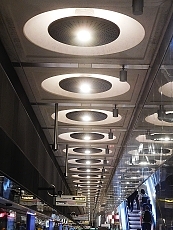 Platform lighting at Paddington Station (Elizabeth Line)
Platform lighting at Paddington Station (Elizabeth Line)Today, I asked an official whether the east and west branches of the Elizabeth line will ever be connected, so as not to need to change trains at Paddington. He said that the infrastructure (tracks etc) are already in place, but there is a problem that still needs to be solved. The problem is that the signalling system on the western part of the line is completely different from that on the eastern part. Surely, someone could have solved this problem during the many years it has taken to construct the Elizabeth Line(s)?
July 6, 2022
St Cuthbert’s extraordinary lectern in London’s Earls Court
HIDDEN IN A residential crescent, Philbeach Gardens, near Earls Court is a late Victorian church, whose exterior is far from attractive. However, St Cuthbert (completed 1888) has an interior which cannot fail to amaze the visitor’s eyes. The church contains what can only be described as an ‘over-the top’ array of decorative features. Some of them are typical of the Gothic Revival style beloved of Victorian church designers, and others that are typical of the Arts and Crafts Movement, which flourished in the last decades of the 19th and the first few of the 20th century.
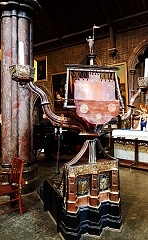
One item in the church, which is particularly eye-catching, is made of wrought iron and hammered (repoussé) copper. It is a lectern with two large arms on either side of the leather-covered book holder. These are supports for large candles. The lectern is approached by a small set of stairs whose treads have studs on them. The studs are arranged to spell out words, which I found difficult to decipher. The part of the base facing the congregation is an intricately decorated folded screen with Arts and Crafts Style decorative motifs. Most probably handmade, the lectern, although fantastically crafted, has a very slightly amateurish look about it. It is more unusual and eye-catching than beautiful.
I would not have visited St Cuthbert had my friend, the excellent Olsi Qinami, not been conducting the London City Philharmonic Orchestra performing a concert there. The church with its colourful marble pillars and almost surreal interior is well worth a visit even if there is no concert being performed. It is a ‘must-see’ for lovers of Victorian church architecture.
July 5, 2022
Floral celebration for a queen
July 4, 2022
Queen Elizabeth and the Elizabeth Line
THE VICTORIA LINE began carrying passengers in late 1968 when I was 16 years old. I remember when this happened and how exciting it was. Recently a new railway line opened in London: the Elizabeth Line. Originally named ‘Crossrail’, it began carrying passengers several years after it was supposed to have been completed. It is supposed to convey people from east of London to well west of the city. However, what exists now (July 2022) is not exactly what I expected. In order to travel from, say, Shenfield, at the eastern end of the line to, say, Maidenhead, west of London, you need to change trains at Paddington. Currently one section of the new line runs east from Paddington, and the other runs west from that station. Unlike Queen Elizabeth’s long continuous reign, the line named to honour her has a discontinuity at Paddington.
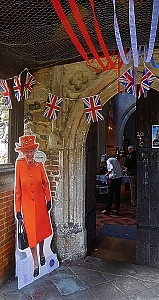
A visitor from abroad wanted to experience the new line today, a Sunday. He was looking forward to seeing the new station platforms on the line that heads east from Paddington. Sadly the section that fruns east from Paddington does not operate on Sundays at the moment. So, we had to head west. The Elizabeth Line trains are new, but the train follows tracks that were laid down as far back as the 19th century. Apart from being over efficiently air-conditioned, the new trains are comfortable and run remarkably smoothly.
We travelled (on a train bound for Heathrow Terminal 5) to Hayes and Harlington station, and from there headed to Barra Hall Park in the old part of Hayes. There, we enjoyed a picnic before walking to the mediaeval parish church, St Mary the Virgin. We had visited it once before, but were completely unprepared for what we saw this time. The hedges lining the path leading to the south door of the church were decorated with bunches of cut flowers. A cardboard cut-out of Queen Elizabeth II greeted us at the door. The lovely church was filled with attractively arranged bouquets of flowers. Quite by chance, we had arrived whilst the church’s 57th annual Festival of Flowers was being celebrated. We were fortunate because we arrived on the 3rd of July, the last day of the festival. The festival’s theme was “A Tribute to Queen Elizabeth”. How appropriate to have travelled to it on the Elizabeth Line.
July 3, 2022
An Australian artist in London
THE ARTIST DAMIEN Hirst has given London’s art lovers a great gift. In October 2015, he opened his Newport Street Gallery (near Lambeth Bridge) to the public. Housed in a former theatre scenery workshop, which has been beautifully modernised, the gallery puts on a series of exhibitions of artworks (mainly paintings) from Hirst’s enormous personal collection, which he has been creating since the late 1980s. The current exhibition, “Cloud of Witness”, which ends on the 10th of July 2022, is of works by an artist born in Australia, who created many of his paintings in London: Keith Cunningham (1929-2014). I had never heard of him before seeing the exhibition.
Cunningham arrived in London in 1949 and enrolled at the Central School of Art and Design, where he aimed to improve his skills as a graphic designer. In 1952, having developed an interest in painting, he joined the Royal College of Art (‘RCA’), where he worked alongside now famous artists including Leon Kossoff, Joe Tilson, and Frank Auerbach. He exhibited in the prestigious London Group in 1956 and the two years following. This group had been formed as an association of modernist artists, who wished to escape the restrictive criteria of the Royal Academy. In 1964, he was invited to become a full member of the Group, but for unknown reasons he declined. By 1967, he had ceased exhibiting his work and was making his living as a graphic designer and teaching at the London College of Printing. Despite this, he continued producing paintings until his death. He kept his paintings hidden from view in a spare room. So, it is fortunate for us that Damien Hirst acquired many of them and put them on public display this year.
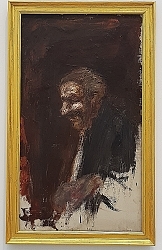
The Newport Street Gallery website (www.newportstreetgallery.com) describes his work succinctly:
“Cunningham’s paintings were produced in London during the post-war period, an artistic environment dominated by the likes of Francis Bacon and Lucian Freud. A student at the Royal College of Art in the mid-1950s, Cunningham worked alongside major artists such as Frank Auerbach, Leon Kossoff and Jo Tilson.
Cunningham’s sombre paintings, coated in layers of dense, sculptural brushstrokes, are populated by skulls, fighting dogs and darkly altered human figures. Like his schoolmates and teachers at the Royal College, Cunningham was interested in figurative painting, transforming the reality of everyday life into loose, slowly disintegrating forms.
His canvases, like those of Bacon, Kossoff and Auerbach, are covered in powerful strokes of dark pigments conveying strikingly expressive forms. The Cloud of Witness seeks to redefine Cunningham’s role in the London art scene of the 1950s, highlighting not only his ability but also the variety of his inspirations. To this effect, it coincides with the major show at the Royal Academy of Arts, Francis Bacon: Man and Beast, encouraging visitors to compare and contrast the works of these two artists.” Having already seen the Bacon exhibition at the Royal Academy and works by other artists mentioned in the quote, I feel that it is a good summary of what we saw at Newport Street. My favourite works in the exhibition were some of the portraits and some of the more abstract works. Undoubtedly, Cunningham was a competent artist, but having seen the exhibition, I can understand why he is not amongst the better-known artists of his generation

